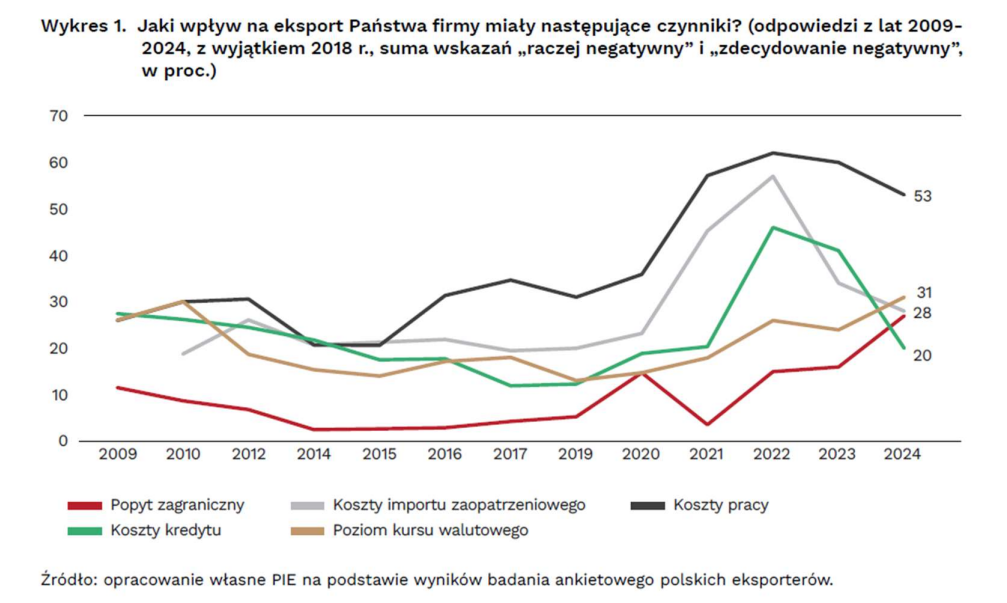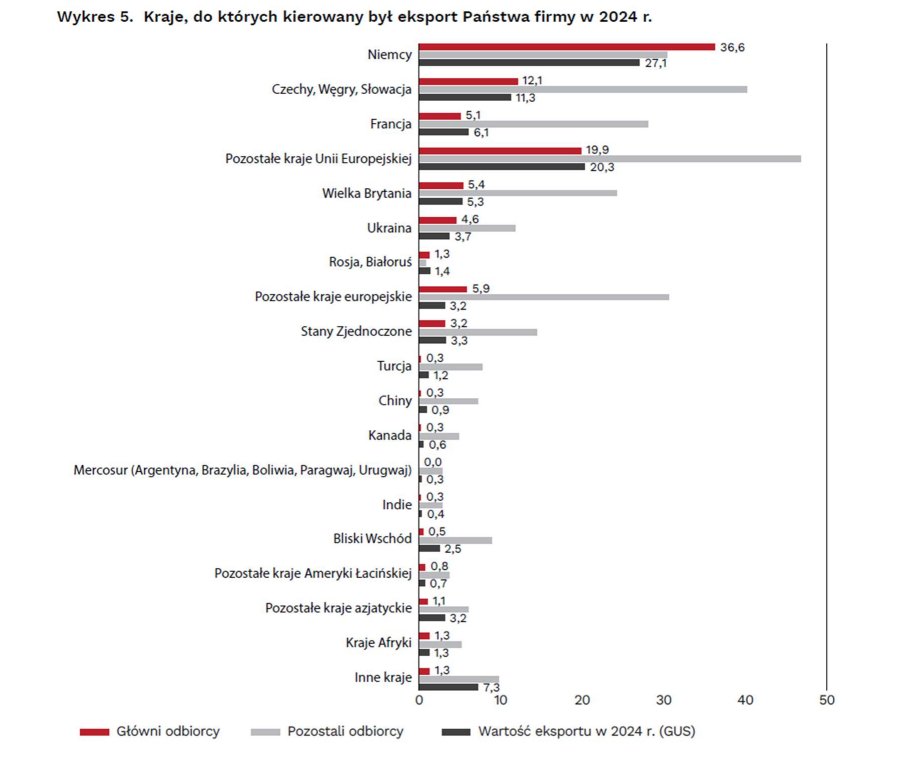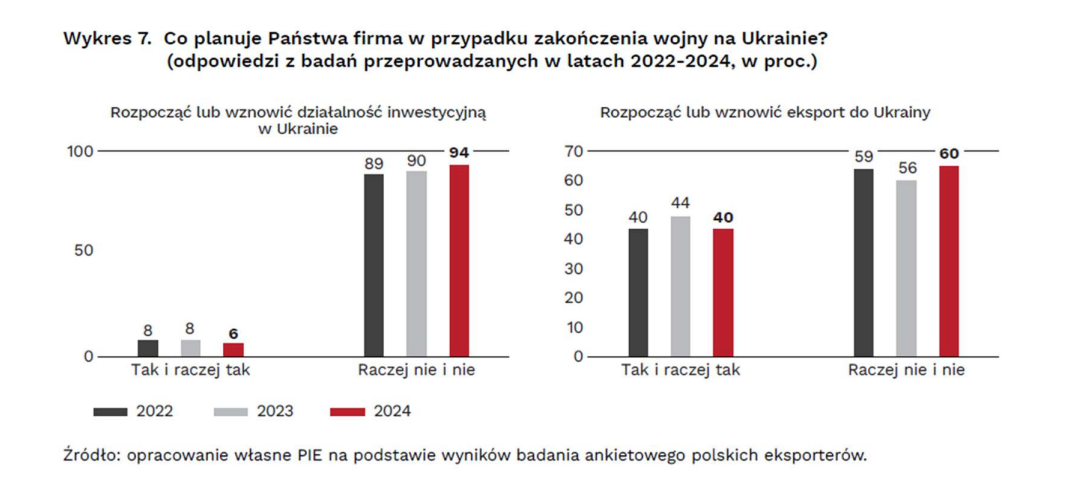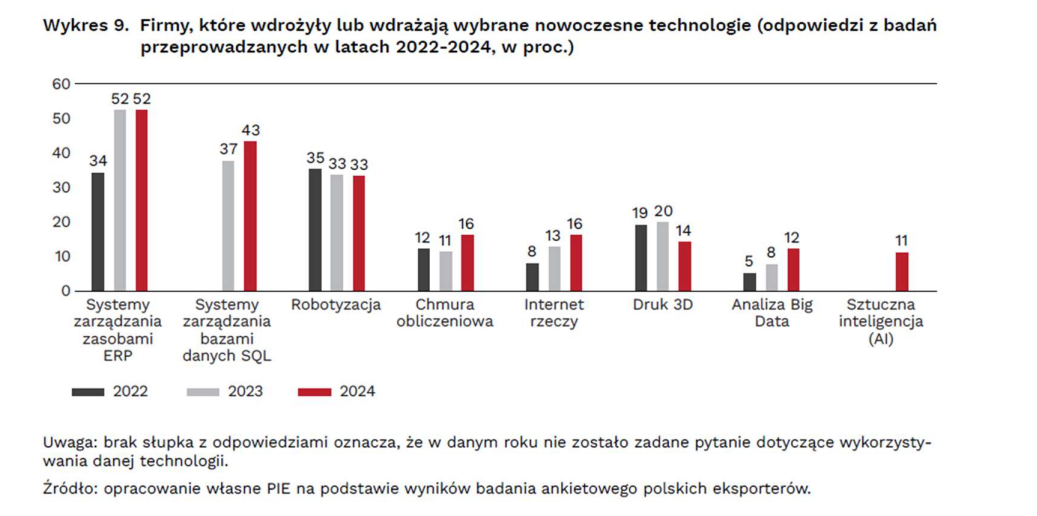Polish exporters continue to compete on price. Many are considering Ukraine.

- The percentage of Polish exporting companies affected by the global economic turmoil fell from 80% in 2023 to 66% in 2024.
- The market strategies of companies exporting goods from Poland have remained unchanged for years and are based on price competition. Exporting companies are more innovative than companies in Poland in general.
- Exporters are also increasingly investing in new technologies – the implementation of AI-based solutions is twice as common in exporting companies than in other Polish enterprises.
- Although the percentage of companies affected by the economic slowdown decreased in 2024 compared to previous years (from 80 in 2023 to 66%), the majority of exporters still declare a negative impact of external factors, such as low foreign demand or an unfavorable exchange rate for exports - according to a publication by the Polish Economic Institute "Polish exporters in times of uncertainty".
However, the data shows that Polish export companies are adapting to changing external conditions.
The level of uncertainty among entrepreneurs has decreased- The diminishing impact of the economic situation on exporters' activities may be related to a rebound in GDP growth in the European Union in 2024 and adaptation to new conditions in foreign markets. The level of uncertainty among entrepreneurs is decreasing. Following the economic growth that occurred in 2022-2023, the level of uncertainty among entrepreneurs has decreased.
Exporting companies are increasingly less likely to implement adjustment strategies to maintain the company's financial and economic condition, such as adjusting sales prices to changing conditions, comments Dr. Katarzyna Sierocińska, senior analyst in the global economy team at the Polish Economic Institute (PIE).

Exporters assessed the barriers to the EU single market more favorably than in previous years. More than half (51%) of exporters pointed to the need to expand common certificates and standards in 2024. However, this was 14 percentage points less than in 2022.
A similar decline was noted after the introduction of easier employment arrangements for foreigners, which may be due to the overall decline in foreign employment in exporting companies (from 62% of exporting companies in 2023 to 53% in 2024). Fewer negative responses were also reported regarding other barriers that have been observed for years.
The need to extend the validity period of permits, reduce the frequency of inspections, and limit tender criteria favoring domestic companies was reported by approximately 4 percentage points fewer companies than in 2023. Exporters also assessed the conditions for exporting to non-EU markets as more favorable, mainly due to the decline in prices and transport costs, reduced risk, and increased government support for exports.
The strategy of Polish exporters has not changed for yearsThe PIE report argues that Polish exporters' competition in foreign markets has for years been based on product price. In 2024, over half (53%) of exporting companies employed a pricing strategy or a pricing strategy with some elements of non-price competition.
The share of exporters relying solely on non-price competition has remained at a mere 2-3% for at least the past 12 years, the period for which we have data for this question. In 2024, the highest share of this type of company was among companies exporting high-tech products.
The profile of Polish exporters has also remained unchanged for years. European Union countries remain the dominant destination for Polish exports.
In 2024, the majority of Polish companies indicated Germany (36%), the Visegrad Group countries (12%), France (5%) and other EU countries (20%) as their main export destination.
Moreover, exporters in Poland are primarily large companies employing over 250 people (42% in 2024) and small companies (36%). In 2024, 78% of exporting companies operated in a B2B model, and 14% offered their products directly to consumers (B2C). 67% of companies exported only goods of their own production. These were primarily small companies and those with annual exports value of less than €100,000.

The PIE report shows that 40% of Polish exporters surveyed in 2024 were interested in starting or resuming exports to Ukraine, although only 6% would like to invest in the country after the end of the war.
The relatively high percentage of companies interested in exporting to Ukraine has remained constant since the beginning of Russia's full-scale invasion and is responsible for the growth of Polish sales to this market. The percentage of companies interested in a presence in the Ukrainian market increases with the higher level of technological advancement of their production.
Companies in the chemical, machinery, and food industries most frequently reported resuming or resuming exports after the end of the war. Most exporters, 76%, did not experience losses related to the war in Ukraine. The remainder primarily felt the indirect consequences of the armed conflict, citing the loss of eastern markets, inflation, and disruptions in the transportation of goods.

In 2024, 11% of exporters have implemented or are in the process of implementing artificial intelligence, and 20% are considering using AI in their businesses. This is almost twice as many as all companies operating in Poland.
In 2024, 5.9% of enterprises declared they were using AI technology. Exporting companies in the machinery and equipment manufacturing sector are most likely to use AI, but producers of chemicals and chemical products, rubber and plastic products, and food products are also considering implementing this type of technology.
These are primarily large companies, with exports accounting for sales revenues exceeding €10 million. The years 2022-2024 saw a significant increase in interest in Big Data analysis, cloud computing, the Internet of Things, and SQL database management systems.

One-third of companies have implemented or are implementing robotics. A similar trend has persisted since 2022. Interest in ERP resource management systems increased significantly between 2022 and 2023, remaining at a similarly high level of 52% for the past two years.
wnp.pl





